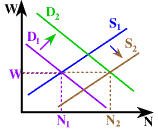 1. In this example there isn't sufficient time for the supply
of web programmers to increase, only the demand curve for web programmers shifts out. The demand increase leads to an increase in both the
number of programmers and their wages. In
the graph to the right, D2 represents the increased demand, W2
the higher equilibrium wage and N2 the increased number hired.
1. In this example there isn't sufficient time for the supply
of web programmers to increase, only the demand curve for web programmers shifts out. The demand increase leads to an increase in both the
number of programmers and their wages. In
the graph to the right, D2 represents the increased demand, W2
the higher equilibrium wage and N2 the increased number hired.

If there had been time for the supply of web programmers to increase
(time for more people to obtain the necessary skills), the supply
curve would have shifted out as well. In this case, even more people would
have been employed, but the change in their wage would have been indeterminate. The graph to the left illustrates such a scenario.
Let's consider the incorrect choices one by one:

